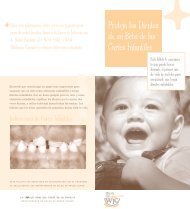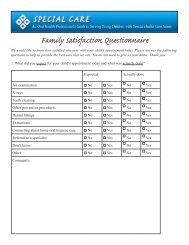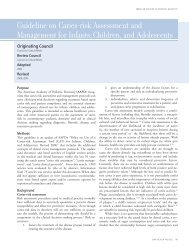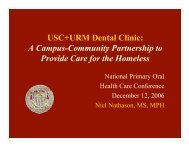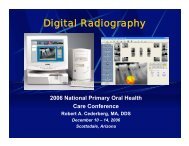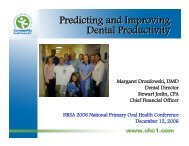Adult/Caregiver Handouts
Adult/Caregiver Handouts
Adult/Caregiver Handouts
- No tags were found...
You also want an ePaper? Increase the reach of your titles
YUMPU automatically turns print PDFs into web optimized ePapers that Google loves.
FLUORIDE• Makes teeth stronger and protects them from tooth decay.• Is found naturally in water and some foods.• Is added to many community water systems (tap water) whenthere isn’t enough natural fluoride.• Is also available through drops, tablets, gels, toothpastes,mouth rinses, and varnishes.• Ask your doctor or dentist which type of fluoride is right for youand your family.1
SPOTS ON TEETHWHAT DOES TOOTHDECAY LOOK LIKE?• White spots on teeth are the first sign of toothdecay. They look chalky and white and arefound near the gums where plaque forms.These spots can be reversed if they arebrushed and kept clean. Early cavities are notthe only white spots that can be found. A dentistcan tell the difference between early decay andwhite spots that are not health problems suchas those that are from too much fluoride.• If the teeth are not brushed and taken care ofthen the white spots will turn in to brownspots on the teeth. This is more advancedtooth decay. Any brown spot is not normal andshould be checked by a dentist. Just becausethe brown spot doesn’t hurt, doesn’t mean it’snot a cavity.4
NUTRITIOUS SNACKSMeal and snack choices can play a big partin the health of your teeth.Between meals, help control plaque,bacteria and acids by:• Eating healthy, low-sugar snacks• Limiting how often snacks are eaten• Avoiding sweets that stick to the teeth5
TOOTH DECAYOR CAVITIES• The most common type of cavity starts in thegrooves of the back teeth which cannot becompletely cleaned by brushing, but wherefood usually sticks. Cavities also start onsmooth surfaces that can easily be brushedand flossed.• When it comes to cavities, how often sugaryfoods are eaten is more important than theamount eaten. Changing the diet to decreasehow often sugar is eaten is very important.• Plaque + food + teeth = cavity or decay.7
BAD BREATHBad breath can be caused by:• Poor oral hygiene• Food debris• Certain foods like garlic and onion• Dry mouth• Tobacco products• Medical disorders• Gum diseaseIf you don't brush and floss every day then food collectsbetween the teeth, on the tongue and around the gumscausing bad breath. So brush your tongue when youbrush your teeth.See your dentist if bad breath does not go away8
BLEEDING GUMSGums that bleed can be a sign of gingivitis which is an infectionand swelling of the gums. Symptoms include:Red, soft or swollen gums, bad breath and bad taste in the mouthcaused from not brushing and flossing the teeth every day.Pregnant women and untreated diabetics are more likely to getgingivitis.Gums that bleed can also be a sign of periodontal disease.Periodontal disease causes infected gums to pull away from theteeth because of damaged bone around the teeth. Left untreatedyour teeth may become loose and fall out.Brushing and flossing are the best ways to prevent gingivitisand periodontal disease.Bleeding can also be caused by injury to gums from sharp objectslike a tooth pick if not used carefully.9
CHANGES IN MOUTH ANDGUMS DURING PREGNANCYHormone changes during pregnancy can cause gumdisease, resulting in:• Tender, swollen or red gums• Gums that bleed when you brush or floss• Bad breath or a bad taste in your mouth that won’t goawayIf you already have sign of gum disease, your pregnancycould make it worse.You may also develop a swelling on the outside of thegums called a “pregnancy tumor”. These are rare andusually appear in an area where you have gingivitis. It'sgenerally painless and harmless and usually disappearsafter delivery.If these occur, see your dentist.11
PLAQUE• Cavity-causing bacteria live in plaque.• Plaque is a soft, yellow-white, sticky materialfound on teeth and gums.• Plaque irritates the gums and causes toothdecay.• Daily brushing and flossing removes theplaque and helps keep teeth and gumshealthy.• If plaque is not removed from the teeth daily,the gums become red, soft and swollen andbleed easily during tooth brushing.12
Tobacco Causes:• Bad breath• Stained, yellow teeth• Build up of tartar• Mouth sores• Facial wrinkling and appearance of aging• Precancerous white patches or plaques• Cancer of the throat, voice box andesophagus (leading to stomach)• Delayed healing after oral surgery andtooth extractions20
Signs and Symptomsof Oral Cancer• A persistent sore that does not heal (after 2 weeks).• Color changes such as red or white patches in the mouthor on the lips.• Pain, tenderness or numbness anywhere in the mouth orlips.• A lump, thickening, rough spot, crust or small worn area.• Difficulty in chewing, swallowing, speaking or hoarsenessthat does not go away and moving the jaw or tongue.• Change in the way your teeth fit together.• Repeated bleeding from the mouth or throat.• Swelling, lump or growth anywhere in or about the mouthor neck.21
Complications of Oral Piercingand Wearing Oral JewelryYou may:• Develop excessive saliva and drooling.• Have difficulties saying words clearly.• Have problems with chewing and swallowing food.• Have allergic reactions to the metal in the jewelry.• Have loss of sensation in the tongue.• Develop gum disease.• Develop an infection of the skin or oral tissues.• Chip or break teeth on jewelry.• Have prolonged bleeding, swelling and nerve damage.• Experience tooth loss.• Contract hepatitis B, C, D and G.• Choke or swallow jewelry that comes loose in yourmouth.• Be at risk of inflammation of the heart.22



